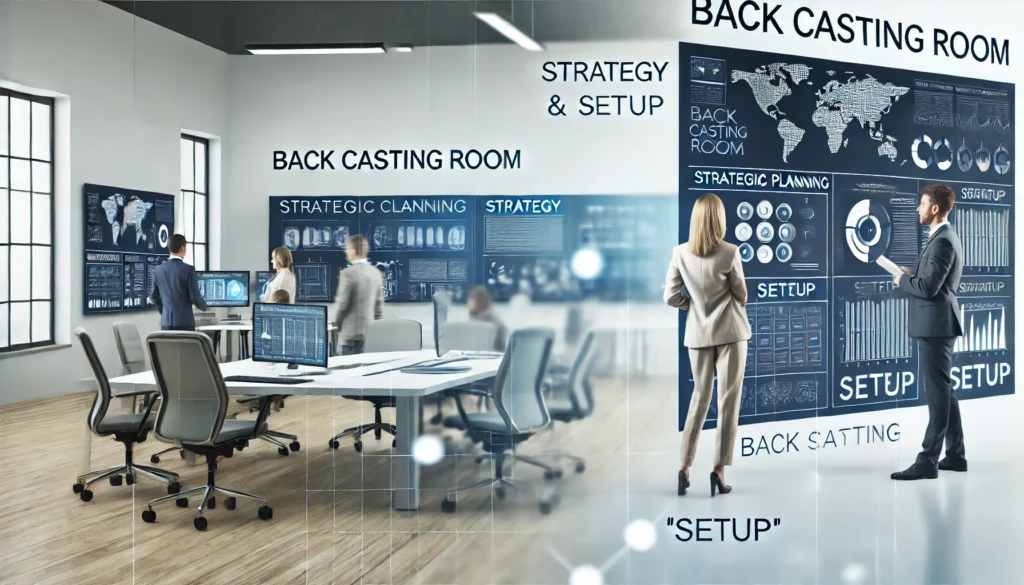Introduction to the Back Casting Room: Definition and Importance
The back casting room is a specialized concept often used in strategic planning and production settings. It’s a space designed to visualize future outcomes, set goals, and work backward to develop strategies. Whether applied to business planning, urban development, or media production, a back casting room helps organizations map out a clear path to achieve their desired future. This guide aims to explain what a back casting room entails, its key principles, setup, benefits, challenges, and future trends.
Historical Background and Evolution of Back Casting Rooms
The concept of back casting and the idea of a back casting room have deep historical roots. It began with strategic thinkers who used dynamic models to project desirable future states and worked backward to achieve them. During the mid-20th century, pioneers like John B. Robinson and Dennis Meadows introduced back casting as a method to address complex issues such as sustainability and resource management. Today, the back casting room has evolved to include sophisticated technology and diverse applications beyond traditional strategic planning.
Principles and Key Features of a Back Casting Room
The effectiveness of a back casting room depends on several key principles:
Future Visioning
Developing a clear and inspiring vision of the future is central to the back casting process. This vision acts as a guiding light for all strategic decisions.
Scenario Building
After establishing a vision, the next step involves building alternative scenarios. This helps explore different pathways and determine the most viable options to reach the desired state.
Identifying Pathways
With a clear vision and scenarios in mind, it’s crucial to identify pathways or strategies that bridge the gap between the present and the desired future.
By incorporating these principles, a back casting room becomes an effective environment for strategic planning and innovation.
Innovations in Back Casting Room Technology
The back casting room concept has benefited significantly from technological advancements. Here are some notable innovations:
Digital Planning Tools
Technologies like AI-powered simulation models and scenario planning software enhance the ability to create detailed future projections and alternative scenarios.
Data Visualization
Advanced data visualization tools allow organizations to map out complex strategies clearly and understand the implications of various pathways.
Collaborative Platforms
With the rise of digital collaboration tools, back casting rooms are now virtual as well, enabling real-time team collaboration regardless of location.
Key Components of a Successful Back Casting Room Setup
A back casting room requires essential components to operate effectively. Here’s a breakdown of what makes a successful setup:
Technological Equipment
From high-quality monitors and audio systems to strategic planning software, having the right technology is key.
Collaborative Environment
Ensure that the layout promotes easy interaction and brainstorming among stakeholders.
Visualization Tools
Large screens, interactive whiteboards, and digital projectors help visualize future scenarios and strategies.
How to Set Up and Optimize a Back Casting Room
Setting up an optimized back casting room involves careful planning. Follow these steps to create an effective environment:
Define Your Goals
Establish clear goals for the back casting room. Understand the outcomes you want to achieve.
Choose an Appropriate Space
Select a quiet location with minimal distractions. Consider the future expansion of equipment and team size.
Install Technology and Equipment
Invest in quality visualization tools, software, and digital collaboration platforms.
Optimize Acoustics and Lighting
Use soundproofing materials to reduce noise interference and ensure that lighting is adjustable and comfortable for long sessions.
Measuring Success in a Back Casting Room
One essential aspect often overlooked is how to measure success in a back casting room. Consider these success indicators:
Achievement of Future Goals
Evaluate whether the strategies developed in the back casting room lead to the achievement of the envisioned future.
Stakeholder Satisfaction
Regularly gather feedback from stakeholders on the room’s effectiveness in fostering collaboration and strategic planning.
Adaptability to Change
The back casting room should facilitate flexibility in planning, adapting to new challenges and opportunities as they arise.
Challenges and Solutions in Managing Back Casting Rooms
While a back casting room offers numerous benefits, it also presents some challenges:
Data Limitations
Planning requires accurate data, which can sometimes be unavailable or unreliable. Investing in reliable data sources and analytics tools can help overcome this challenge.
Uncertain Future Scenarios
The future is inherently uncertain. One way to address this is by exploring multiple scenarios and preparing for various outcomes.
Resistance to Change
Implementing new strategies can face resistance from stakeholders. Fostering a culture of openness and adaptability is key to overcoming this hurdle.
Industry Trends and Future of Back Casting Rooms
The future of back casting rooms is bright, with several exciting trends emerging:
Increased Use of AI
Artificial intelligence is likely to play a larger role in predictive modeling and scenario planning.
Virtual and Augmented Reality
Immersive technologies are poised to transform the way organizations visualize future outcomes and strategies.
Integration with Real-Time Data
The back casting room of the future will likely be more dynamic, incorporating real-time data to update strategies and pathways as conditions change.
Comparing Back Casting Rooms with Other Production/Strategic Methods
It’s essential to understand how back casting rooms compare to other planning or production methods:
Back Casting vs. Forecasting
While forecasting relies on past data to predict future trends, back casting focuses on defining a desired future and then working backward to identify steps to achieve it.
Back Casting vs. Traditional Brainstorming
Unlike traditional brainstorming sessions, a back casting room uses structured techniques to align all efforts toward a clearly defined future state.
Back Casting vs. Agile Planning
Agile planning emphasizes short-term iterations and adaptability, while back casting is more focused on long-term visions and goals.
Case Studies: Successful Back Casting Room Implementations
Here are two examples of how a back casting room has been successfully implemented:
Urban Sustainability Planning
Copenhagen used back casting to create a roadmap to become carbon-neutral by 2025. The city worked backward from this goal to identify necessary investments in green infrastructure and energy.
Corporate Strategy
Unilever’s Sustainable Living Plan began with a future vision of doubling the size of its business while reducing environmental impact. Through back casting, the company devised strategies for product innovation and waste reduction.
Conclusion: Unlocking the Potential of a Back Casting Room
In conclusion, a back casting room is a valuable tool for strategic planning and production, enabling organizations to define a clear future and work backward to identify the necessary steps to reach that goal. Whether in business, urban planning, or media production, leveraging the power of a back casting room helps navigate uncertainties, plan effectively, and drive success.
By understanding the principles, setting up a conducive environment, and adopting innovative technologies, organizations can unlock the full potential of their back casting room to achieve desired outcomes and navigate complex challenges.


